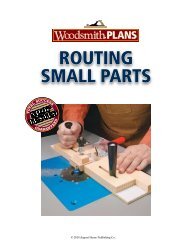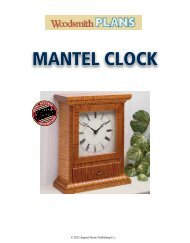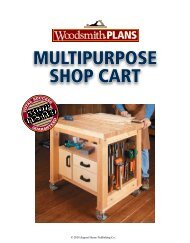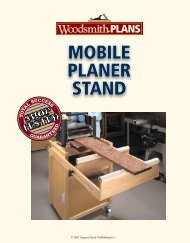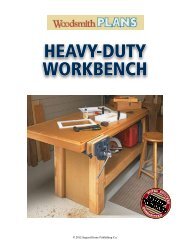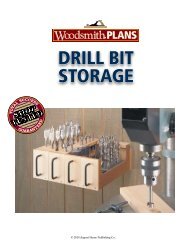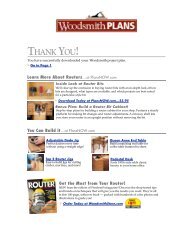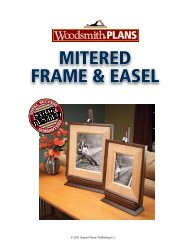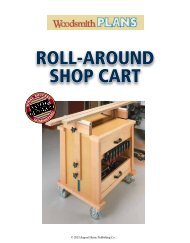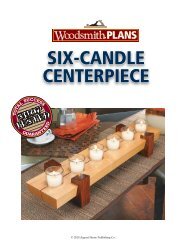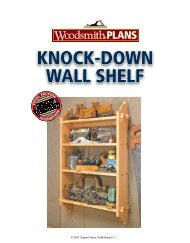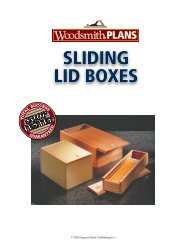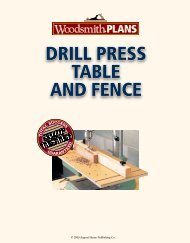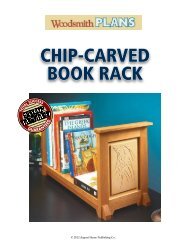STACKING SAwhorSeS - Woodsmith Shop
STACKING SAwhorSeS - Woodsmith Shop
STACKING SAwhorSeS - Woodsmith Shop
Create successful ePaper yourself
Turn your PDF publications into a flip-book with our unique Google optimized e-Paper software.
Construction<br />
At this point, the basic groundwork<br />
for the set of sawhorses is complete.<br />
Now it’s just a matter of cutting the<br />
end pieces to final shape and connecting<br />
them with the top, shelf, and<br />
supports (Exploded View).<br />
REMOVE WASTE. First, remove the bulk<br />
of the waste from the area inside the<br />
notch and around the tab. There’s<br />
no need to lay out these areas. Just<br />
use double-sided tape to attach the<br />
template to each end piece, and use<br />
a band saw (or jig saw) to rough out<br />
the basic shape, as in Figure 3.<br />
As you do this, make sure you<br />
don’t accidentally cut into the edge<br />
of the template. I make it a point<br />
to keep the saw at least 1 ⁄ 8 " away<br />
from the edge. This leaves a small<br />
amount of material that can be<br />
removed quickly and easily.<br />
ROUT TO SHAPE. Now you can rout<br />
the end piece to final shape with a<br />
flush-trim bit mounted in the router<br />
table (Figure 4). The idea here is to<br />
adjust the height of the bit so the<br />
bearing rides against the edge of<br />
the template. This way, the cutting<br />
edge of the bit trims the end piece<br />
perfectly flush with the template.<br />
3<br />
ATTACH<br />
TEMPLATE<br />
WITH<br />
DOUBLE-<br />
SIDED<br />
TAPE<br />
The router bit will leave the inside<br />
corners of the end piece slightly<br />
rounded. That’s okay for the notch.<br />
But the “ears” around the tab will<br />
need some additional work.<br />
FILE CORNERS. For the tab on the top<br />
sawhorse to fit all the way into the<br />
a.<br />
notch of the one below, you’ll need<br />
to clean up these corners. A few<br />
strokes with a file is all it takes to get<br />
them nice and straight (detail ‘a’).<br />
CHAMFER TAB. While you’re at it, it’s<br />
a good idea to file a chamfer on<br />
the inside edge of the tab. This will<br />
make it easier for the tab to slip into<br />
a notch when stacking sawhorses.<br />
JOINERY. After repeating this process<br />
for all of the remaining end<br />
pieces, you can concentrate on the<br />
joinery that’s used for assembly.<br />
To provide sturdy support for<br />
the top of the sawhorse, it sits in a<br />
rabbet in the top edge of each end<br />
piece. And to strengthen the shelf, it<br />
fits into a dado.<br />
AUXILIARY FENCE. But before cutting<br />
either the rabbet or dado, I attached<br />
4<br />
FLUSH-TRIM<br />
BIT<br />
3 www.<strong>Woodsmith</strong>.com © 2010 August Home Publishing Co. All Rights Reserved.



